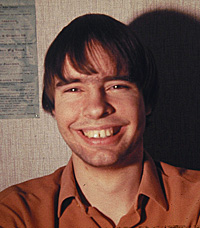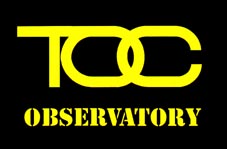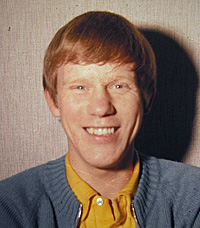


Flemming R. Ovesen / Torben Taustrup



Flemming R. Ovesen / Torben Taustrup
The TOC History
Flemming is born in 1950, and I am from 1951. We met in school back in 1965 (the image is from our graduation in 1968. I'm far left - next Flemming, Marianne, Willy, Per and Arne, another of my very good friends), and soon we discovered that we shared a passionate interest for technical things.
At the age of fourteen we bought our first telescopes. It was small telescopes - Flemming bought a 50 mm refractor and I purchased a 42 mm Newtonian - both telescopes on ALT/AZ mounts. We observed the Moon, stars and a bright object that we thought was Jupiter - it was not, as it stood in the northern part of the sky. In those days we had great plans of building a big telescope. We contacted an optometrist and he made an offer on the mirror optics - 300 Dkr. - we did not have that kind of money so the small scopes had to do.
We started building electronic things as well as mechanical devices in Flemming's fathers workshop in the cellar. Among other things we made a 97 cm long model of Jules Vernes legendary "Captain Nemo" submarine "Nautilus" . It's capable of sailing submerged. It's 60 mm propeller is driven by a DC motor. The motor is powered via a wire and a battery on land.
We spent a period of time building model sailplanes. In the beginning it was kits, later we developed our own small fast flying models.
Rocketry
Inspiret by the race to reach the Moon one of our passions became rocket building.
The first models was made of rolled paper with a thin metal envelope and with a stick on the side for stability. Later models were made of aluminium with a cylinder diameter on 25 mm - still with a stick attached to them. For safety we always used electric ignition - for this purpose we had a firing control box.
Some launches went well - and some not so well - this one exploded in the air and the burning fuel pellet fell to the ground.
For rocket fuel we used salpetre and sugar - the two ingredients were mixed with alcohol and by compressing the fuel in the rocket cylinder it was transformed into a hard pellet once the alcohol had evaporated. At this state the combustion was easier to control - but often we had an explosion. One of our friends said, that it would be fun to fire a rocket from under water - he was not sure that we could do it and we made a bet. We launched it in his garden from a bucket filled with water - it didn't go far though.
At a time we found it neccessary to make a test stand in order to measure the power of the thrust - actually we made quite a lot of ground tests either by sticking the rocket in the ground or attaching it to a garden fence. This is our first rocket test stand before a test. This is during a test - and this is after the test.
Our goal was to make "a real rocket" without a stick - the Alpha became the first one - it had a total length of about 30 centimeters - it had a paper cone nose. This concept proved to be optimal, and the rocket flew as expected. For safety reasons we never launched this rocket 100% vertical. For launching we had a ramp made of wood. After launch we would go and look for the rocket - in the direction in which the ramp pointed - and we always found it. Another way to track the rocket was to build in a transmitter - which we did. But we never got to actually testing it.
One Alpha rocket had a built-in light bulb in the nose. This would make it easier to see, where it went down. Despite this it was launched in bright daylight. We had no problems finding this one.
A new and improved control box was built. Later we developed a larger model - the Beta with a 38 mm outside diameter cylinder. For this rocket we made a new test stand. We borrowed Flemmings' parents bathroom scale and fixed the rocket to it with some electric wires. As tests usually took place at night, we had to establish illumination for the scale as we filmed the event - and recorded the sound as well.
At a distance of fifteen meters Flemming pressed the firing button and the rocket engine started hissing quite loud. After approximately three seconds the engine exploded with a hand grenade-like boom - later my uncle who lived 6 kilometers away from the the test site told me that he had heard the explosion that night.
The scale was still there - but not in working order any more. Flemming was not very happy about the situation - the scale was useless, so I took it home to my parents. They were already awake - the explosion was to blame and they had a pretty good idea about who and what caused it. When my father saw the scale he started laughing out loud - I found it quite amusing myself.
We did some experimenting with rockets with a built-in parachute but we never got that one working.
Diving
In 1968 we began snorkel diving. - and in that year we made our first underwater camera. I borrowed my parents old "Ferrania" box camera and fitted it into a cookie can - this is one of the first - this is Flemming. Later we made an aluminium submersible box for my Konica C35 - 24 x 36 camera, and image quality improved. Here is one of the first pictures taken with this camera.
Here are some more - Flemming - and here - This is me - and this one and find Nemo
We also got a rubber boat
In 1969 TOC (Taustrup Ovesen Cooperation) was established - we found it quite amusing to have a "company" to relate to. To make it official we wrote The TOC Charter- a document stating the statutes of our partnership. In short it describes how to divide the expenses and what kind of things we should spend our time with - things that we found interesting of course. The document is still in our possesion - actually it's framed and hanging on the wall.
Flemming and Torben anno 1969
For a period of years we did nothing about astronomy, but in 1985 we got together again and made plans for building a "big" scope - an 8 inch f/6 Newtonian. We began building the instrument the same year - our goal was to observe, and hopefully take pictures of Comet Halley with it. However, constructing the telescope took a lot more time than we expected, and we missed Halley by a year or so.
In the spring of 1989 we started building our first observatory building and dome. September 18th the same year the dome was put into place with the aid of a truck crane, and we could start practising astro photography at a more serious level.
The telescope was modified many times. We had a flexure problem and tried to solve it by reinforcing the tube - but at the end decided to construct a new tube which by the way also solved a problem with scattered light.
The first drive system was a syncronous motor operating at 24 VAC. An electric circuit made it possible to adjust the frequency and we could guide the telescope with adequate precision. The declination drive was operated by a DC motor connected to a gearbox, and with this system we were able to make very precise adjustments.
In 1997 we finished building The Cookbook Camera and we had to find place for a computer and the CCD camera control unit. A built-in shelf with access from the workshop became the solution. The old R.A. drive motor was at a time replaced with a steppermotor and now it was possible to scan. The modification made it much easier to find objects in the sky. We still had to rely on the setting circles and initial setting could take some time.
A new focuser was built - this time with motordrive. I was possible to adjust focus both when standing in the observatory and in the control room (workshop).